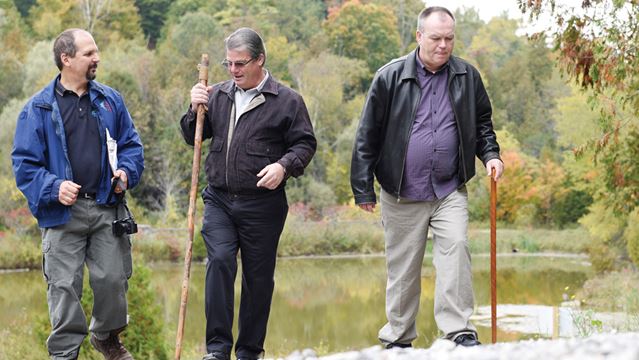Restoration of ‘abandoned’ pit at Heber Down property in Whitby complete
Repair of eroded bank and reuse of concrete debris helps enhance safety and access for visitors
Whitby This Week

HOW THIS IMPACTS YOU
WHITBY -- Visitors of Heber Down Conservation Area in Whitby will now find it easier to explore the sprawling property without worrying about hazards.
The Central Lake Ontario Conservation Authority recently marked the completion of the habitat restoration of an old aggregate pit in the area -- a popular destination for local residents seeking recreational opportunities close to home. At a cost of about $100,000, the Ontario Aggregate Resources Corporation repaired an eroded bank and reused concrete debris to create a safe access road to the Devil’s Den Pond, which is one of the site’s main attractions.
“We’re here today to recognize and celebrate a significant improvement to Heber Down,” said Chris Darling, CLOCA’s chief administrative officer, at the unveiling of the rehabilitated spot on Oct. 7.
“There was an area with an eroded gully where there was concrete and rebar debris ... we directed the trails away from this area but there were still people that came here and it was definitely a hazard.”
Established in 1958, CLOCA’s mandate is to create and undertake programs to promote the conservation, restoration, development and management of natural resources in partnership with the Province and local municipalities. CLOCA has five conservation areas spanning more than 45 kilometres of trail and other public facilities.
The Heber Down Conservation Area (main entrance at 500 Lyndebrook Rd.) is spread out over 284 hectares with opportunities for various activities, including hiking, fishing, picnicking, and wildlife viewing. The site sees about 20,000 visitors each year.
“This area is heavily used by both recreational users as well as people who just want to come here and enjoy and appreciate nature,” said Mr. Darling.
“It’s one of the conservation areas within our watershed that’s actually pretty close to an urban setting so it’s unique in that way. It also protects a provincially significant wetland and important wildlife habitat.”
Through its Management of Abandoned Aggregate Properties program, TOARC rehabilitates pits and quarries across the province that are deemed abandoned under the Aggregate Resources Act. In reality, these former extraction sites have not been abandoned but remain the property of individuals, corporate entities and municipalities. They are typically small sites (less than two hectares), were created as the result of small-scale operations (municipal wayside pits, private use pits or intermittent commercial operations) and are generally unregulated.
“When the (Act) was put into effect back in 1990, the aggregate industry represented by the now Ontario Stone Sand and Gravel Association decided to dedicate half a cent per tonne of licence fees paid by the aggregate producer to a program responsible for rehabilitating these legacy sites,” said Danielle Solondz, program co-ordinator with TOARC.
“Based on recent levels of extraction in the province, we have about $400,000 to $600,000 made available annually for this program. In addition to rehabilitation, we also fund research with these monies that helps us figure out better ways to do rehabilitation.”
To date, MAAP has worked with landowners to rehabilitate more than 680 hectares of land at a cost of nearly $8 million -- free of charge to the landowner. In Durham, the program has rehabilitated 20 sites covering 30 hectares at a cost of $367,000.
In 2012, MAAP initiated discussions with CLOCA to develop a habitat restoration plan for the Heber Down site, particularly what was to be done with the concrete and rubble that had been deposited at the site. Construction began last year for primary exploration of the debris piles to determine the quantity of concrete that could be recycled in the access road. The project was completed this past summer.
Whitby Mayor Don Mitchell, who’s also chairman of CLOCA’s board of directors, said the biggest benefit of the restoration project is the improved access it offers members of the community. “You can now come to this area, you can access the pond, the trail and all this backdrop in a safer way and you can let your kids play in this area too,” he said.
“It was quite unsafe at the top of the hill; it was all just rebar and jagged stuff, so that’s the biggest impact because it’s a place where we want people to come and just be able to relax and enjoy themselves.”
HOW THIS IMPACTS YOU
• The newly completed habitat restoration at Heber Down Conservation Area means improved access and safety for the approximately 20,000 people who visit the site each year.
• The legacy pit was primarily in use from prior to 1971. In 1972, it was then licensed by an Oshawa construction company for five years when the licence was cancelled and the property sold to CLOCA. The habitat restoration cost The Ontario Aggregate Resources Corporation about $100,000.
• This is the second event held in Whitby recently to highlight improved access to local outdoor recreational spots. On Sept. 24, the community celebrated the completion of the Waterfront Trail at Lynde Shores, which was funded through the Ontario Ministry of Tourism, Culture and Sport ($600,000), National Trails Coalition Grant Program ($45,000) and Shell Fueling Change ($10,000).


No comments:
Post a Comment